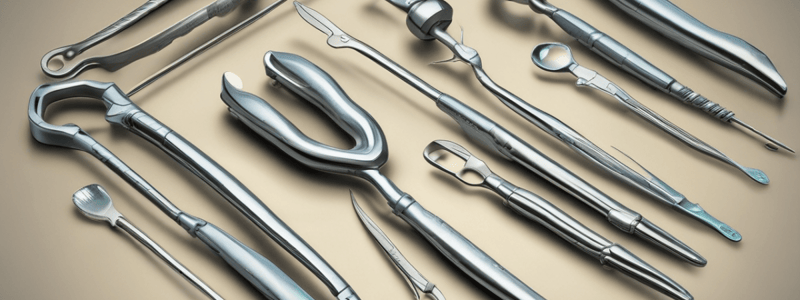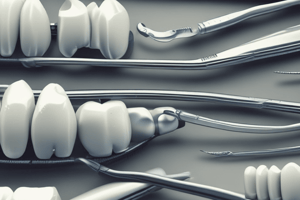Podcast
Questions and Answers
What is the primary purpose of balance contra-angling in dental instruments?
What is the primary purpose of balance contra-angling in dental instruments?
- To provide a comfortable grip for the operator
- To increase the cutting edge of the blade
- To allow for the concentration of force onto the blade without causing rotation (correct)
- To facilitate the classification of instruments according to shank angles
What is the maximum deviation from the axis that is allowed for the blade edge in an optimally designed instrument?
What is the maximum deviation from the axis that is allowed for the blade edge in an optimally designed instrument?
- 1 to 5 mm
- 1 to 2 mm (correct)
- 5 to 10 mm
- 0.5 to 1 mm
What is the primary function of the secondary cutting edges in single-beveled instruments?
What is the primary function of the secondary cutting edges in single-beveled instruments?
- To provide additional cutting capacity (correct)
- To extend the length of the blade
- To prevent rotation of the instrument
- To form the primary cutting edge
What is the unit of measurement used to express the width of the blade or length of the cutting edge in an instrument formula?
What is the unit of measurement used to express the width of the blade or length of the cutting edge in an instrument formula?
What is the purpose of the additional number on the handle of some instruments?
What is the purpose of the additional number on the handle of some instruments?
What is the term used to describe instruments with two bevels that form the cutting edge?
What is the term used to describe instruments with two bevels that form the cutting edge?
What is the direction in which the primary cutting edge angle is measured in an instrument formula?
What is the direction in which the primary cutting edge angle is measured in an instrument formula?
What does the angle in the instrument code represent?
What does the angle in the instrument code represent?
What is the unit of measurement for the blade length in the instrument code?
What is the unit of measurement for the blade length in the instrument code?
What is the purpose of chisels in instrument application?
What is the purpose of chisels in instrument application?
Which type of excavator is used for refinement of internal parts of the preparation?
Which type of excavator is used for refinement of internal parts of the preparation?
What is the purpose of angle-formers in instrument application?
What is the purpose of angle-formers in instrument application?
What is the characteristic of a bin-angle chisel?
What is the characteristic of a bin-angle chisel?
What is the purpose of enamel hatchets in instrument application?
What is the purpose of enamel hatchets in instrument application?
What is the purpose of gingival margin trimmers in instrument application?
What is the purpose of gingival margin trimmers in instrument application?
What is the primary purpose of the shank in a hand instrument?
What is the primary purpose of the shank in a hand instrument?
What is a characteristic of a handle in a hand instrument?
What is a characteristic of a handle in a hand instrument?
What type of cutting instrument uses electric or compressed air power?
What type of cutting instrument uses electric or compressed air power?
What is the name of the instrument that is used for diagnosis?
What is the name of the instrument that is used for diagnosis?
What is the term for the cutting edge of a hand instrument?
What is the term for the cutting edge of a hand instrument?
What is the purpose of the eight-sided or knurled handle?
What is the purpose of the eight-sided or knurled handle?
What is the term for the type of instrument that is used for manipulation, packing, or condensation and shaping of restorative materials?
What is the term for the type of instrument that is used for manipulation, packing, or condensation and shaping of restorative materials?
Flashcards
Balance contra-angling
Balance contra-angling
This technique helps concentrate force on the blade without causing the instrument to twist.
Maximum blade deviation
Maximum blade deviation
The blade edge should deviate from the axis of the instrument by no more than 1 to 2 mm for optimal cutting efficiency.
Secondary cutting edges
Secondary cutting edges
These cutting edges provide extra cutting power, especially when working on the sides of the preparation.
Instrument formula units
Instrument formula units
Signup and view all the flashcards
Additional handle number
Additional handle number
Signup and view all the flashcards
Bi-beveled instruments
Bi-beveled instruments
Signup and view all the flashcards
Primary cutting edge angle
Primary cutting edge angle
Signup and view all the flashcards
Angle in instrument code
Angle in instrument code
Signup and view all the flashcards
Blade length unit
Blade length unit
Signup and view all the flashcards
Chisels
Chisels
Signup and view all the flashcards
Spoon excavators
Spoon excavators
Signup and view all the flashcards
Angle-formers
Angle-formers
Signup and view all the flashcards
Bin-angle chisel
Bin-angle chisel
Signup and view all the flashcards
Enamel hatchets
Enamel hatchets
Signup and view all the flashcards
Gingival margin trimmers
Gingival margin trimmers
Signup and view all the flashcards
Shank
Shank
Signup and view all the flashcards
Handle
Handle
Signup and view all the flashcards
Rotary cutting instrument
Rotary cutting instrument
Signup and view all the flashcards
Mirror
Mirror
Signup and view all the flashcards
Blade
Blade
Signup and view all the flashcards
Eight-sided or knurled handle
Eight-sided or knurled handle
Signup and view all the flashcards
Restorative instruments
Restorative instruments
Signup and view all the flashcards




